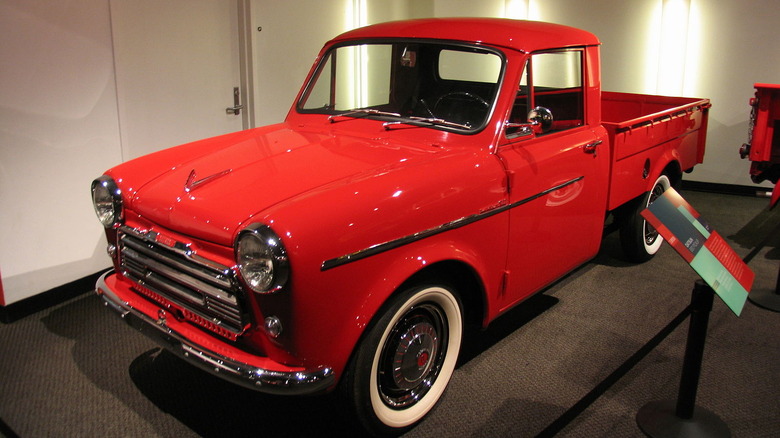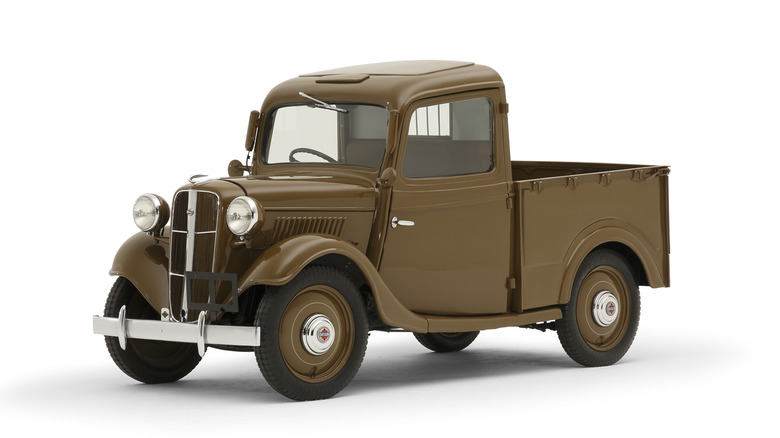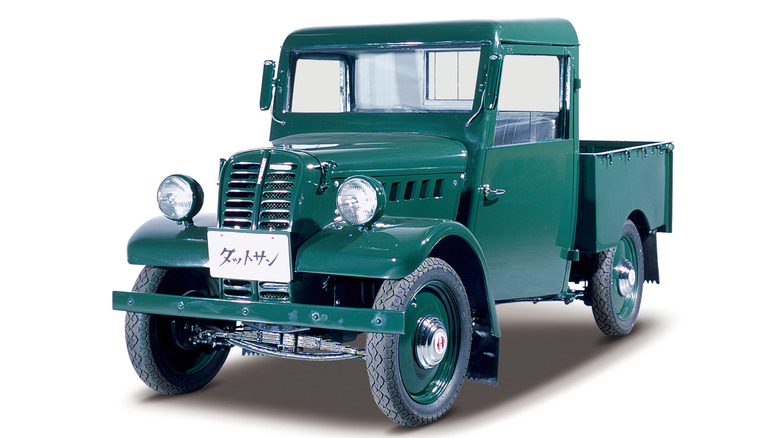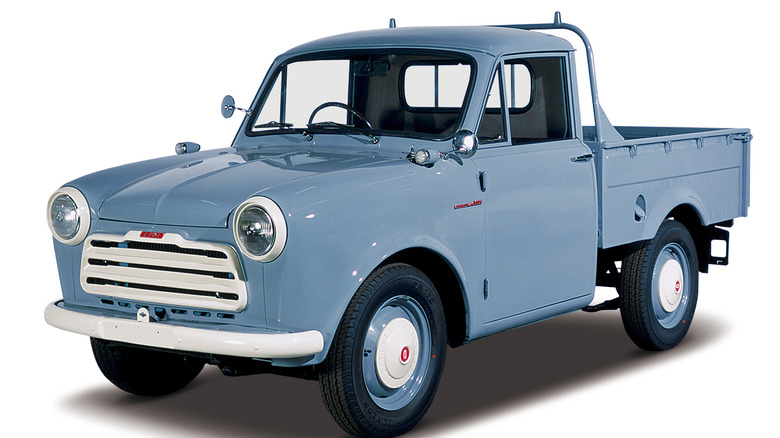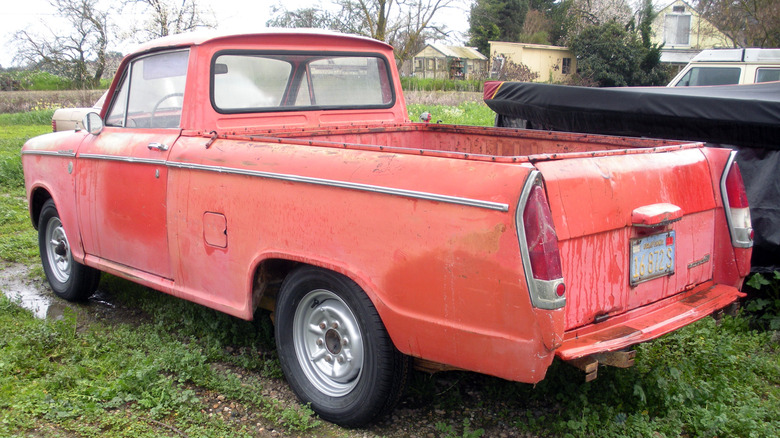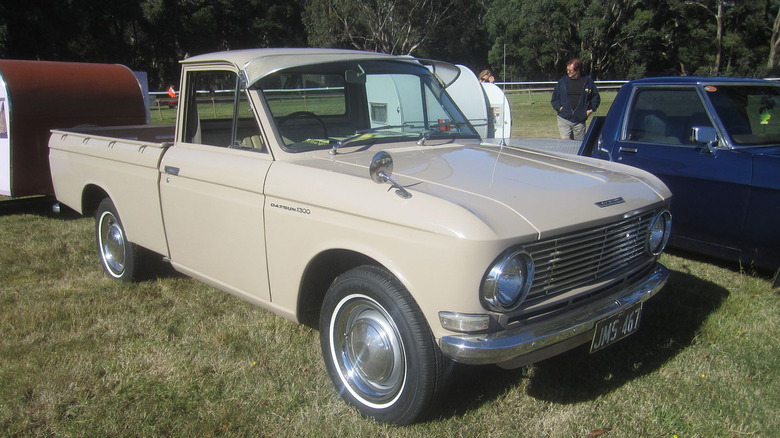5 Of The Best-Looking Datsun Pickup Trucks Ever Produced
Honda, Nissan, and Mitsubishi recently started merger talks that would make the combined company the third-largest automaker in the world behind Volkswagen and Toyota, but Nissan's corporate history is already quite complex. The company produced its first car in 1914, calling it the DAT after the last initials of the company's three founders. The first DAT truck was built in 1918 for the Japanese Army, although the end of World War I forced DAT to shift its focus back to passenger cars. The company changed its name to Datson – or "Son of Dat" — in 1931, and the spelling was changed to Datsun in 1933. That same year, parent company Nihon Sangyo began using the ticker symbol NISSAN on the Tokyo Stock Exchange.
Datsun came to the United States in 1958, and in 1984 began a costly global effort to rebrand all its models and dealerships under the Nissan name. Nissan resurrected Datsun in 2014 for use on cheaper models in limited markets across Asia and Africa, but dumped the name again in 2022. In its heyday, the Datsun label went on magnificent sports cars like the 240Z and the earliest generations of the iconic Skyline, as well as some truly gorgeous pickup trucks.
The 17T was Datsun's last pre-war truck
The Datsun Type 15 became Japan's first mass-produced vehicle in 1937, and was issued as a convertible, pickup truck, and van. It was quickly updated twice, with Datsun adding a number to the model designation each time.
The Nissan 17T pickup that was produced in 1938 has more historical pre-war charm than traditional good looks, with its sneering nose and strangely angled cab and bed. The front fenders and sweeping running boards are undeniably beautiful, though, and attractive to anyone who appreciates antique vehicles. Up front, the 17T shared a vented hood and 16 horsepower, 722 cubic centimeter four-cylinder engine with its predecessor, the 16.
The 17T's small footprint made it ideal for commercial use in Japan's crowded cities. It had a wheelbase of about 6 feet, 7 inches and was under ten feet long. It was also less than four feet wide, which made it easy to squeeze down the narrowest alleyways and into the smallest of parking spaces. The 17T was the last Datsun truck produced during peacetime before the company began cranking out vehicles for Japan's World War II effort.
The 2225 was a late '40s gem
Once production of civilian vehicles resumed after World War II, Datsun got quickly back to work producing pickup trucks for its commercial customers. The 1121 came out in 1946, just after the war's end, and the beefier and better 2225 appeared a year later. The 2225 had a similar upright stance as the 17T, but the front end was distinctly '40s with its fender-mounted headlights. The front fenders were wide and had a broad arc, covering 16-inch body-colored wheels that also matched the ones in back.
The 2225's Type 7 four-cylinder engine made just under 15 horsepower and about 27 lb-ft of torque, and the truck could haul just over 1,100 pounds. It had a two-seat cab and a transmission with three forward gears and reverse. Post-war material shortages and the national reconstruction effort forced Datsun to get creative with the manufacturing process; some of the 2225's body was made of wood.
The 220 helped bring Datsun to the U.S.
By the late '50s, Datsun was ready to break into the North American market. The 210 sedan and 220 pickup, with which it shared a platform, debuted in Japan in 1957, and the following year both models were exhibited at the Los Angeles Auto Show. The 210 and 220 arrived at dealerships soon after, sharing a 988 cubic centimeter four-cylinder engine that was the company's first with an overhead valve architecture.
The engine cranked out just under 35 horsepower and about 48 lb-ft of torque, enough to get the roughly 1,400-pound truck to its top speed of just under 56 miles per hour. It sat two people and could haul up to almost 1,900 pounds. It's sometimes known as the 1000 or 1200, and was made in four iterations through the 1962 model year. A few have survived the half-decade plus since they were made; two 1960 models with some engine modifications sold in 2021 and 2022 for $25,000 and $20,000, respectively.
The NL320 was a rare and special model
As the years progressed, so did the model numbers on Datsun trucks. The 320 was introduced in 1961 and had a few improvements, including a bigger cab, 1.2-liter engine, and an independent front suspension. The L320 version had a standard truck frame that clearly showed the break between the cab and bed, while the NL320 fused the two halves of the body together, as shown above.
This difference made the doors and cab of the NL320 about six inches longer than those of the regular 320, and the decidedly '60s taillight assemblies were borrowed from the Bluebird. Only about 1,000 NL320s were sold in the United States from 1963 through 1965, although it was more popular in Australia, Thailand, and other overseas markets. L320s aren't terribly common on the secondhand market, but NL320s are veritable unicorns. Classic.com shows only two as having changed hands over the last five years: one sold in 2023 to a lucky buyer for just $10,750 and the other went a year earlier for $55,000.
The 520 represented a design shift for Datsun trucks
Fortunately for us car lovers, the design of Datsun trucks was much more creatively inspired than their naming convention. Datsun took a break from the predictable standard by skipping from 320 to 520, eschewing 420 because of a bit of linguistic superstition. Autoblog cites a Nissan historian as verifying that the numbers 4 and 2 are a near homophone for the word for death in Japanese. That prompted the company to avoid using it on the next model in its line of pickups.
The model 520 and 521 pickups were made from 1966 through 1972, and had more angular elements up front than their 1950s and early '60s predecessors. By 1969, the 520 series was graced with the 77 horsepower J15 inline four-cylinder engine. These trucks are popular with the lowrider crowd because, frankly, they look cool when squatting down on all fours.
